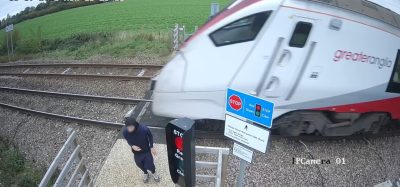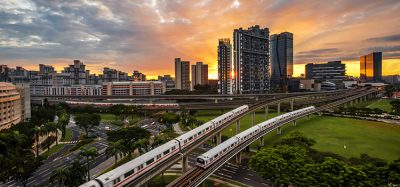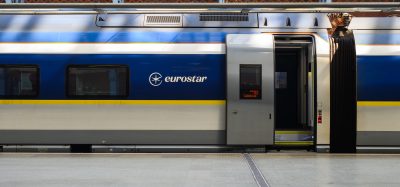Security during construction for the Brenner Tunnel North Access Section
Posted: 12 December 2009 | | No comments yet
The North Access Section to the Brenner Tunnel is particularly important to rail transport within Europe as part of the TEN 1 – Axis Berlin-Palermo in a north-south direction and as the main east-west traffic artery in the junction with the Lower Inn rail link. Security, in particular, is a topic with a crucial role to play in the design and construction of the railway engineering infrastructure, due to its complexity and tight timeframe.
The North Access Section to the Brenner Tunnel is particularly important to rail transport within Europe as part of the TEN 1 - Axis Berlin-Palermo in a north-south direction and as the main east-west traffic artery in the junction with the Lower Inn rail link. Security, in particular, is a topic with a crucial role to play in the design and construction of the railway engineering infrastructure, due to its complexity and tight timeframe.
The North Access Section to the Brenner Tunnel is particularly important to rail transport within Europe as part of the TEN 1 – Axis Berlin-Palermo in a north-south direction and as the main east-west traffic artery in the junction with the Lower Inn rail link. Security, in particular, is a topic with a crucial role to play in the design and construction of the railway engineering infrastructure, due to its complexity and tight timeframe.
The railway engineering infrastructure in the Lower Inn (Tirol) Valley consists of the 41km-long Kundl/Radfeld-Baumkirchen section, which is mainly of new double track construction. The underground sections are led through a single main tunnel tube. This length of line is particularly notable for its high proportion of tunnel works, with a total of 34km double track tunnel designed for a maximum operating speed of 250km/h. The modernisation of the whole route has the main aim of considerably speeding up and increasing the capacity for transporting people and goods between northern Europe and Italy.
Brenner Eisenbahn GmbH (BEG), a subsidiary of ÖBB Infrastruktur Bau AG, has awarded Austria’s largest ever contact for railway engineering infrastructure, which has a total value of approximately €260 million, to the consortium ALPTRANSIT BRENNER (Rhomberg Bahntechnik GmbH / Alpine Bau GmbH).
Join our free webinar: Rail cyber-security in a time of technological and regulatory transformation
Join our expert panel, including speakers from Nokia and Siemens Mobility, to explore the critical convergence of cybersecurity and 5G rail comms.
Date: 3 Dec | Time: 15:00 GMT
Can’t attend live? No worries – register to receive the recording post-event.
The railway infrastructure works for the whole length specified in Contract A1 for ‘basic infrastructure’ cover the following bullet pointed works, which in their entirety embrace the same security concept as all the remaining infrastructure contracts. With this overall concept, the client has given security the importance which it deserves and which is essential in a project of this magnitude:
- Overall coordination of the site/site management
- Completion of the tunnel shell
- Slab track with mass-spring systems
- Finishing works in 33 shaft heads and seven service buildings
- Security system installations (sluice chambers, doors and gates)
- Cable placement for security systems, power supply and telecommunications
- Installation of noise protection equipment
- Installation of extinguishing water system
- Overall logistics coordination and security management
- Provision and operation of the temporary works required to construct the project
Overall coordination of the site/ site management
The design and execution of the railway engineering infrastructure on the Kundl/Radfeld-Baumkirchen section imposes very high demands on all the project participants, particularly in relation to the quality and functionality of the systems, the complexity of the scheme as a whole, the long contract period, the challenging project deadlines, the fulfilment of the high security objectives and the cooperative working and interface management of a large number of parties and people.
The overriding objectives are completion of the works in compliance with the programme and in accordance with the quality requirements, bringing into operation of the section observing the priority areas of security, value for money, handover of works in mint condition, durabity and complete integration of all the provided systems.
Completion of the tunnel shell
The tunnel shell works include the installation of the concrete fill, joint seals, drainage pipes, side walkways and cable routes, cable and cleaning shafts in the side walkways, drainage in the crossways and rescue galleries, bituminous surfacing in the rescue galleries and access ramps and sluice chamber walls.
Slab track with mass-spring systems
The whole tunnel system incorporates approximately 69km of slab track. This is ÖBB’s standard system, which consists of flexibly supported 5.16m x 2.40m track slabs. A mass-spring system is installed on 28km of track to reduce vibration and structure-borne noise. Full-area and point support systems are used for the track slabs for the vibration range 5.5 to 20Hertz (at 10 to 7to/m).
Overall logistics coordination and security management
The project presents particular challenges in relation to logistics and security, principally in the areas discussed below. Underground there is a complex system of long main tunnels, rescue galleries, crossways, connecting and side galleries. This system has a limited number of vehicle access points. Movement within the tunnel using road vehicles is made difficult by abrupt level differences and discontinuities in the tunnel floor. Rail and road vehicles have to move in the tunnel throughout the various construction phases. Different contractors work at the same time at different locations, each using the same logistics infrastructure, all of which must be coordinated. The limited amount of storage space in the tunnel system adds to these difficulties and joint use of the temporary works and installations on site cannot be avoided. On the surface, the amount of traffic on the roads limits their usefulness to site vehicles, therefore a temporary traffic infrastructure must be provided during the whole contract period. Logistics management has two main aspects:
- The control and coordination of all activities on the site and on each part of the site from a central control room
- The management and operation of the site facilities
Further areas of emphasis include structured information, resources and programming management system covering internal and external project participants. The necessary security is ensured by the following:
- Compliance with general safety requirements and procedures
- Strict implementation of the security plan during the whole construction and commissioning phase
- Systematic maintenance of all engineering facilities and equipmentCurrent information about the number and present locations of all the people and vehicles in the tunnel and gallery system is displayed in real-time in the security control room (personnel and vehicle positioning system)
- Training and instruction on security matters of everyone employed on the site before they start work and followed up with regular refresher sessions (security training)
- Stringent checks and compliance with safety regulations to avoid hazards to people working on site and third parties
- Personal protective equipment must be used
Provision and operation of the temporary works required to construct the project
Temporary works are required to complete the railway engineering infrastructure. They form a system which is completely independent of the final system and ensures security and efficiency during the construction phase. These temporary works have been designed to be installed and used immediately after taking possession of each section of the tunnels before the installation of the actual railway engineering infrastructure starts. These facilities are only dismantled and removed after the final infrastructure has been successfully commissioned. During this stage the security of all systems is monitored by the central control room. The temporary works include:
- Site electrical power supply
- Site lighting
- Site communications (cables and radio)
- Operation of the central control rooms for security and logistics
- Tunnel alarm system
- Access control and positioning of people and vehicles
- Ventilation of the tunnel system
- Sanitary faciities
- Temporary signage in the tunnel and site control system
- Temporary ramps, bridges for traffic routes in the tunnel
- Site roads and accesses
- Site flooding control measures
Security during the project
The monitoring of security represents a great challenge on this complex project with its multiple entry and exit points and the geography and timing of the handover of its different sections. In addition, the design of the systems for the overall security concept must take the many project participants into consideration during the installation and commissioning phases (contractors providing the basic infrastructure, electrical equipment 50Hz and telecommunications, signalling, control and security technology). These works as well must have adequate infrastructure and the security aspect is important in the coordination of the construction site.
A reliable and adequately designed site electricity supply is indispensible for the present and later infrastructure installation works. Security is an important aspect in site communications as is the necessary ‘external connection’ for the coordination of the works inside the tunnel. Therefore, redundancy provision is a particular characteristic of this project.
With a major site of this size, the access system has been designed to the latest standards and proven up to the task. In addition, extensive and difficult to supervise sites require a positioning system so that in the event of an emergency, all the necessary rescue services can be quickly and effectively coordinated. This includes a visual and audible alarm system in the tunnel, which is monitored from the central security control room.
The main electrical power supply comes on to site at 25kV and is reduced to 10kV for distribution throughout the length of the works. Every 1,000 to 1,500m, a 10/0,4kV transformer reduces the voltage to 400V and distributes the power in the tunnel. The transformer locations were placed outside the tunnel wherever possible, so as not to unnecessarily restrict the space inside. Only in areas with parallel rescue tunnels were they placed in recesses or crossways.
Distributors with a 63/32A CEE outlet are placed every 125m to which mobile supply posts (small site power distributors) or mobile ventilators (fans) can be connected.
Emergency power generators are present at all main electrical power feed points. These generators start up automatically when there is a power failure to ensure work can continue uninterrupted.
Uninterruptible power supply (USP) units with sufficient capacity for three hours are installed for certain system components (communications, emergency lighting, access and positioning). The central security control room also has its own emergency power generator and an additional UPS for the most important components, such as communications and the access and positioning systems.
The detection of the failure of a system is reported immediately to the central security control room and at the same time an SMS alert is automatically sent to the duty electrician.
Site lighting within the tunnel consists of lighting which is designed for humid areas with diffusers at 15m centres of which every second light is fitted with a rechargeable battery which automatically provides three hours of light in the event of a mains power failure. The complete lighting system can be controlled from the central security control room. Controlling the lights from a central point reduces electricity costs during long periods when work is not taking place on the site.
A WLAN radio network was designed and installed first at one tunnel working location to enable site communication. Determinant in this decision was the objective of creating a network which would be as universal as possible by using a standardised communications protocol (ethernet protocol) and therefore avoid having to convert to and from other signal types, such as analogue systems. The communications infrastructure is networked through an extra fibre optic cable, which was part of the redundancy designed into the system. Every 250m there is a communications and distribution cabinet which houses certain basic components (emergency telephone, alarm indicators and audible signal horn, CEE sockets, I/O modules for data transmission, UPS units) augmented with further components (WLAN access points, access and positioning modules). These cabinets simply connect to the fibre optic cable and a power supply only and therefore are easily replaced if they become defective. This concept can also be adapted to continuously extend the system as more sections of the tunnel shell are released.
The telephone infrastructure was designed to ensure that the emergency telephone system would be as simple as possible to operate and safeguarded against failure. The receiver automatically connects to the central security control room as soon as the handset is raised. The control equipment identifies the telephone and determines the location of the caller, as happens with emergency phones on motorways. A separate telephone communications system is provided for each of the two means of communication (WLAN and emergency) to allow the highest possible level of redundancy.
All the project site communications run through an IP-telephone system, which creates a comprehensive internal means of communication. Site management and operatives can be contacted over the network throughout the whole site area (site facilities areas and tunnel) and can also make calls to the outside world over the public network when they are in one of the site WLAN reception areas.
The WLAN network can also be used to transfer data, for example on a laptop computer. This feature has proved very handy up to now, especially for contractors’ sub-agents.
Groups of workers are able to use an enhancement to the internal communications system in the form of WLAN handsets with a PTT function (Push-To-Talk) and a total of 24 channels. These devices are the equivalent of the multi-channel radios often found on building sites. Key to the choice of a wireless IP-telephone system solution was its robustness. The telephone handsets are resistant to dust, impact and liquids, which is essential for everyday use in a rough construction site environment.
The access and positioning control is operated from the central security control room. All personnel and vehicles that need access to the tunnel register in advance with the central security control room and are issued with a pass, which is an active badge or tag fitted with RFID technology. This pass is traceable to the person and shows his name, photo and company. Vehicle badges are registered using the company name and number plate information. The badges can also be configured with different authorisation rights if necessary.
Access points are equipped with an automatic system housed in a cabinet, which only opens the access barrier if the vehicle standing in front of it has the appropriate authorisation to enter (read from the vehicle badge). The accesses are monitored with video cameras, which give the people in the central security control room a view of what is actually happening there. The details of the occupants of the vehicle are captured and registered from their active tags. Having actively transmitting tags means that they do not have to get out of the vehicle, which is often the case with inactive tags.
Within the tunnel complex (main tunnel, rescue tunnel, rescue shafts etc.), the position of each person or vehicle is determined automatically. There is a tag reader installed in the cabinets at 500m intervals, which reads the active tags and passes the data to the positioning software in the central security control room. This gives the security staff in the control room a rapidly updated visual display of the complete site, as well as a detailed view of the positioning equipment zones. In the event of an incident, the appropriate emergency teams can be quickly coordinated and directed on site.
Personnel in the tunnel can be notified of an emergency by an alarm triggered by the staff in the central security control room. The priority of the alarm is indicated by two rotating lights on the communication and distribution cabinets and an acoustic warning from a signal horn. If the alarm is shown with the orange rotating light then the personnel should speak to the central security control room for information; if the red rotating light is illuminated then immediate evacuation of the tunnel section is necessary. The alarm can be applied to individual sections or to the whole tunnel. The evacuation of the tunnel and the extraction of personnel and vehicles can be followed in the central security control room using the access and positioning software, and the appropriate action taken to rescue anyone not showing up as leaving the tunnel.
The whole infrastructure in the tunnel and the central security control room was designed with a deliberate level of redundancy and the optical cable network was configured as a ring. This allows data transmissions and communications to continue in the event of a fault. As the cabinets are connected by pre-fabricated lengths of fibre optic cable, a defective cabinet can be rectified by simply replacing it. Each communication and distribution cabinet is fitted with an ethernet I/O module and six ethernet ports. This allows a wide range of different signals and data to be transmitted to the central security control room.
Summary
The scope of the temporary works installed on this project to ensure construction site safely and security certainly shows the way forward and the concept is the first of its kind in Austria. With previous major projects involving tunnel construction/ engineering infrastructure installation, the subject of temporary works has been mainly viewed as a secondary consideration and the effects of inadequate site communications – above all with respect to safety – are often underestimated. Communication systems are absolutely essential for the efficient provision of security on tunnel projects, likewise for a reliable and simple means of alerting personnel in the event of an emergency. Simple access control is adequate for projects with a confined and easily supervised project environment but not for long, linear sites where effective coordination of emergency teams is required. This can only be achieved by a means of positively detecting and monitoring the position of all personnel on site.
The expense of these temporary systems may at first glance seem excessive, but when you consider the size of the project, the time necessary to install the engineering infrastructure and the number of different project participants, then this is the right way to secure and coordinate projects of this scope and magnitude. When viewed over the whole of the contract period, the investment pays off because, in addition to the safety and security aspect, the systems simplify coordination of the works (logistics) and reduce supervisory staff costs.
OUT NOW: The Definitive Guide to Rail’s Digital Future
The rail industry is undergoing a digital revolution, and you need to be ready. We have released our latest market report, “Track Insight: Digitalisation.”
This is not just another report; it’s your comprehensive guide to understanding and leveraging the profound technological shifts reshaping our industry. We move beyond the buzzwords to show you the tangible realities of AI, IoT, and advanced data analytics in rail.
Discover how to:
- Optimise operations and maintenance with real-time insights.
- Enhance passenger services through seamless, high-speed connectivity.
- Leverage technologies like LEO satellites to improve safety and efficiency.
Featuring expert analysis from leaders at Nomad Digital, Lucchini RS, Bentley Systems and more, this is a must-read for any rail professional.







